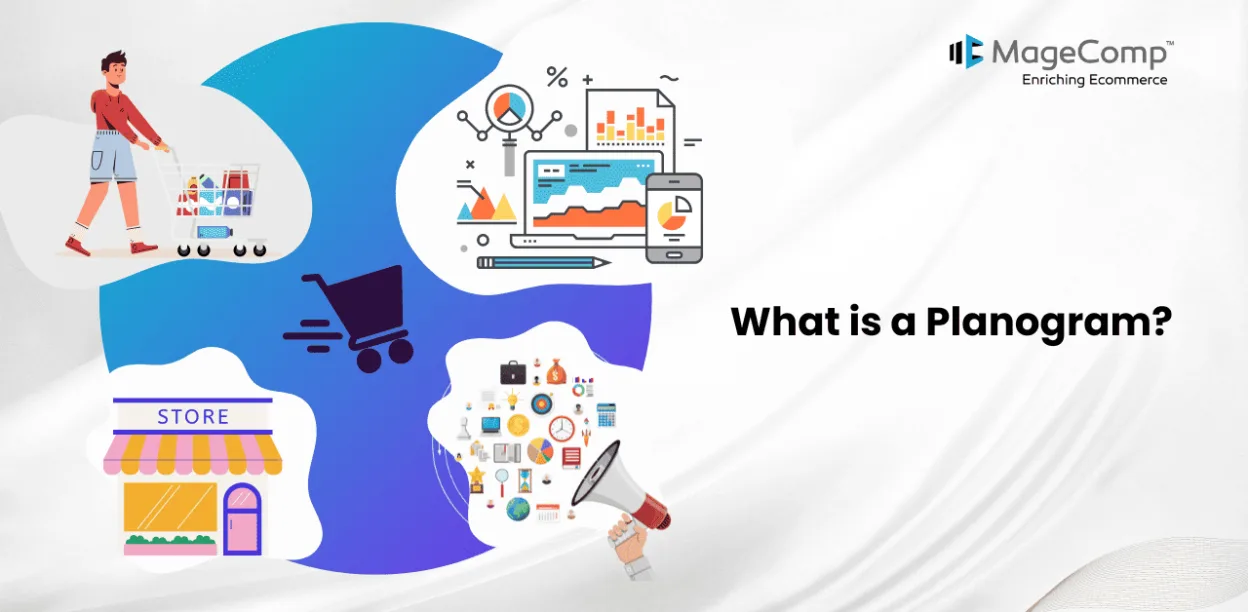Have you ever observed how complementary and similar items are often displayed together in brick-and-mortar stores? This deliberate arrangement is evident in the placement of ketchup next to mustard, as well as the positioning of small candies and trinkets at eye level near the checkout counter.
When it comes to eCommerce stores, it’s important to consider offering incentives like coupons, deals, or last-minute savings to customers right before they make a purchase. Conducting thorough data research is necessary to figure this out, but the most effective way to optimize this process is through the use of a planogram.
What is a Planogram?
Crafting a compelling retail planogram involves creating a strategic visual representation of how products should be organized on store shelves to maximize sales, enhance customer flow, and improve the overall shopping experience. This blueprint acts as a roadmap, guiding retailers on the most effective placement of each item to generate maximum impact within the retail environment.
In designing a planogram, it is crucial to meticulously consider a range of influential factors, including product categories, sales data, foot traffic patterns, and customer shopping behaviors within different areas of the store to maximize its impact effectively.
While planograms have traditionally been associated with physical retail environments, their applicability extends to eCommerce platforms and physical/digital catalogs as well.
What is an eCommerce Planogram?
Ecommerce planograms, also known as visual merchandisers, play a crucial role in shaping the online shopping experience. Their primary function is to organize strategically and present products on a digital platform to captivate users and drive sales.
Just like their physical store counterparts, eCommerce planograms meticulously curate the arrangement of products in virtual shelves or listings to create an enticing and user-friendly layout for online shoppers.
However, what sets e-commerce planograms apart is their dynamic nature. Unlike traditional planograms used in brick-and-mortar stores, they harness the power of technology and algorithms to continuously adapt product displays based on real-time data, user behaviors, and promotional goals. This allows for a personalized and ever-evolving presentation of products tailored to individual preferences and market trends.
Types of Planograms
There are multiple types of eCommerce planograms, specially curated by optimizing them for different category tags:
- Category Plarmogram – Planograms that mainly focus on placing products falling under the same category together, like placing electronic products or cosmetics in separate categories.
- Featured Product Planogram – This planogram emphasizes specific products or promotions prominently on the website or app homepage to maximize visibility and prompt immediate customer engagement.
- Recommendation Planogram – Utilizing data analytics and customer behavior insights, this e-commerce planogram suggests complementary or related products based on browsing or purchase history, creating opportunities for cross-selling.
- Coupon and Deal Planogram – Highlighting products eligible for discounts, deals, or special offers, this planogram aims to attract price-sensitive customers and encourage immediate purchases.
- Last-Minute Savings Planogram – This planogram focuses on showcasing products or services available at a discounted rate for a limited time, leveraging urgency to drive quick purchasing decisions.
By integrating various e-commerce planogram techniques, you can significantly boost traffic to your online store and increase your customers’ spending. For instance, you can strategically feature high-ticket items in product bundles or showcase them in the ‘featured’ category to maximize their sales potential.
The best part is that these planograms are digital, so you do not need to gather new data to make continuous layout adjustments. Instead, you can use personalized algorithms that will automatically group, market, and recommend different items, saving you time and effort.
What is the Importance of Planograms?
Effective planograms are not just about creating an attractive display; they also play a crucial role in the strategic design of a digital retail space. Thoughtful product placement can guide customer behavior, prompting them to notice high-margin items and discover new products.
A well-organized online store enhances navigation, leading to increased customer satisfaction and the likelihood of repeat business.
Besides that, customers value personalization. According to a study, 78% of customers are seeking personalized experiences that help them save money. Moreover, 84% noted that special discount offers or bundled deals significantly influence their purchasing decisions.
Ecommerce planograms are instrumental in delivering personalized offers in your store, making a substantial impact on customer lifetime value and average spending. Therefore, it is important not to overlook their influence.
What are the Strategies for Building an eCommerce Planogram?
Creating an effective e-commerce planogram requires a thorough analysis of your website layout, customer browsing behavior, and sales data. To successfully design your planogram, follow these detailed steps:
1. Gather Comprehensive Data
Tick out the best sellers and slow-selling items of your store by analyzing the sales trends and the navigation path within your online store. Consider external factors such as seasonal trends and market influences to tailor your planogram strategy.
Additionally, stay vigilant for trends in your local area that could inform your planogram strategy. Avoid getting stuck in analysis paralysis; instead, make informed decisions and observe the outcomes to maximize the benefits.
2. Design a Detailed Layout
Outline a digital layout that categorizes your products and prominently showcases best-selling items or promotions. Before proceeding, evaluate your low-ticket items and inventory purchases to avoid making assumptions.
For instance, while you may assume that prominently displaying best-selling categories in the checkout product feed is effective, a thorough analysis of sales data might reveal that a personalized “Often bought with this item…” feed performs better in the checkout flow of your e-commerce site.
3. Leverage Advanced Software
Consider using planogram software to facilitate a more sophisticated approach. These tools enable you to create digital layouts, experiment with different configurations, and account for product dimensions.
Although not mandatory, utilizing such technology can yield substantial returns by saving time and streamlining data analysis. If you are already using Magento 2, the planogram merchandiser can be a valuable tool.
In addition to these steps, here are some advanced tips to elevate your planogram design:
- Keep It Dynamic – Regularly review and update your planograms to align with changing sales trends and customer browsing behavior.
- Embrace Testing – Experiment with different product placements to identify the most resonant options for your customers.
- Innovate Beyond Traditional Displays – Consider incorporating promotional banners, product labels, and interactive elements like quizzes to enrich your product presentation and enhance customer engagement.
Helping hand for Creating a Planogram?
As an e-commerce store owner, having a planogram is essential for gaining a competitive edge and maintaining an organized layout. A planogram serves as a visual blueprint, making it easy to communicate and improve your store’s arrangement.
You can create and manage product placement rules, generate visual reports, and utilize drag-and-drop features within your Magento 2 store.
Using planograms strategically can enhance the shopping experience, increase sales, and encourage customer loyalty.





